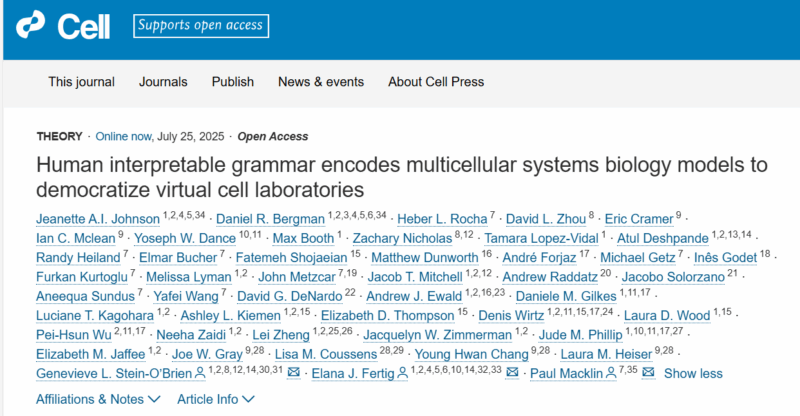Olivier Elemento, Director of the Englander Institute for Precision Medicine at Weill Cornell Medicine, shared a post on LinkedIn about recent paper by Jeanette Johnson et al., published in Cell.
“Democratizing Biology: A New Language for Predictive Simulations
For a while now, I have been excited about using LLMs to more easily create mathematical models of diseases. The idea of translating English into mathematical language is in theory similar to language translation, an area where LLMs excel. This translation is important because a huge gap often exists between the worlds of experimental biology and quantitative modeling.
While this exciting future may one day involve LLMs, a new paper in Cell tackles this translation challenge today with a different, highly structured approach. This work introduces a powerful framework to democratize the creation of predictive biological simulations.
Authored by Jeanette Johnson, Daniel Bergman, Genevieve Stein-O’Brien, Elana Fertig, Paul Macklin, and colleagues, the paper presents a ‘cell behavior hypothesis grammar’—a plain-text language that allows scientists to build complex agent-based models (ABMs) without needing to be expert programmers.
A New Language for Biology
The grammar allows scientists to express biological knowledge as simple, declarative rules, such as “cisplatin increases apoptosis” for a specific cancer cell line. These hypotheses can be drawn from expert knowledge in the literature or derived directly from the analysis of new experimental data.
Structured Translation to Math
These rules are formatted into a structured file that is automatically parsed by custom software, which then deterministically maps each rule onto pre-defined mathematical expressions. This robust, reproducible system effectively bridges the divide between biology and complex mathematics.
Grounding Models in Reality
The framework is designed to directly integrate experimental data to personalize the virtual models. For example, the authors used spatial transcriptomics data from human pancreatic cancer lesions to initialize the exact positions and types of cells in a virtual tissue, grounding their simulations in real-world biology.
I think this work is a significant step forward. By providing an intuitive language to translate biological hypotheses into computable models, it empowers a much wider community of researchers to perform virtual experiments, test complex ideas, and accelerate the pace of discovery.”
Title: Human interpretable grammar encodes multicellular systems biology models to democratize virtual cell laboratories
Authors: Jeanette A.I. Johnson, Daniel R. Bergman, Heber L. Rocha, David L. Zhou, Eric Cramer, Ian C. Mclean, Yoseph W. Dance, Max Booth, Zachary Nicholas, Tamara Lopez-Vidal, Atul Deshpande, Randy Heiland, Elmar Bucher, Fatemeh Shojaeian, Matthew Dunworth, André Forjaz, Michael Getz, Inês Godet, Furkan Kurtoglu, Melissa Lyman, John Metzcar, Jacob T. Mitchell, Andrew Raddatz, Jacobo Solorzano, Aneequa Sundus, Yafei Wang, David G. DeNardo, Andrew J. Ewald, Daniele M. Gilkes, Luciane T. Kagohara, Ashley L. Kiemen, Elizabeth D. Thompson, Denis Wirtz, Laura D. Wood, Pei-Hsun Wu, Neeha Zaidi, Lei Zheng, Jacquelyn W. Zimmerman, Jude M. Phillip, Elizabeth M. Jaffee, Joe W. Gray, Lisa M. Coussens, Young Hwan Chang, Laura M. Heiser, Genevieve L. Stein-O’Brien, Elana J. Fertig, Paul Macklin

More posts featuring Olivier Elemento on OncoDaily.
